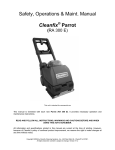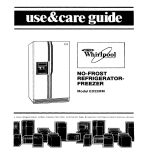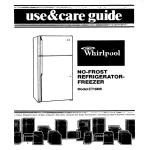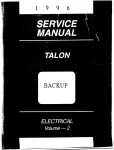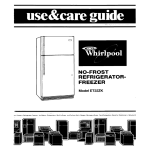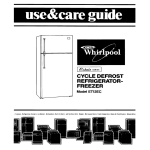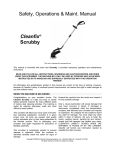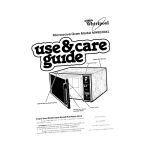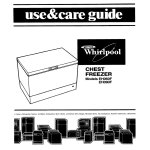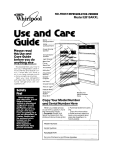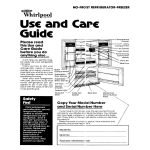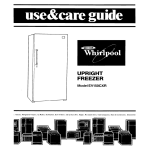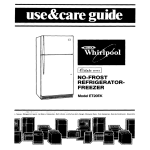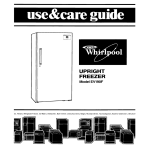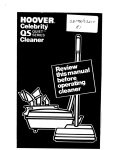Download Whirlpool EHD251CMWR0 User's Manual
Transcript
NO-FROST REFRIGERATOR-FREEZER VLirlpool CORPORAllON USC and Care Guide Please read this Use and Care Guide before you do anything else.. . It will help you get the longest useful life your refrigerator can give. It tells you how to start your refrigerator, clean it, move shelves and adjust controls It even tells you what to do if you hear strange sounds or think something is wrong. Treat your new refrigerator with care. Use it only to do what home refrigerators are designed to do. It will pay you back with the years of service it was built to give. Temperature Control Air Control aFreezer Light Li g h t Ice Maker -” Ice Bin *’ .-nap* Power Saving Control I*---Utility Comportmen Adjustable Shelves Roll-Out Shelf Light ““~---” ABS Panel a* Door Shelves Crisper Pan ” Meat Pan ” Meat Pan Air Control (not shown] Base Grill Model and Serial Number Plate Copy Your Model Number and Serial Number Here “r ‘r. If you have to call for service, the service technician will ask for your Model and Serial Numbers. Your refrigerator has these numbers on a plate just above the base grill. Copy them in the spaces below while you are thinking about it. Keep this book in a handy place. Your warranty and sales slip should be kept with it. i’i ji 9 Model Serial No. No. Purchase/Installation Date Before you plug it in -IMPORTANT ihls ISthe only fine prtnt kc’.. II find in this booklet Please read It to be sure you use your refrigerator properly We build refrigerators to last, but we can’t contro’ how they are used Before using your refrlgerator, you are personally responsible for making sure that It l 1s Installed and leveled on a floor that will hold the tielght. and In an area suItable for Its size 0% use 5 15connectea only to the ,!ght kind of outlet, with the rIghi electric supply CIXZ grounding l l l l l l l is used only for jobs expected of home refrigerators. ISproperly malntained. ISout of the weather. is used in an area where the room temperature will not fall below 55’ F. (13” C). ISnot run where there are explosive fumes IS not used by children or others who may not understand how It should be used. IS not loaded with food before it has time to get properly cold. Pick the Right Place Snug is fine, but do vou want It __ thai way? Save steps by putting your refrigerator near the sink and next to a countertop. It should not be near a stove, radiator, water heater or any source of heat...including direct sunlight. You can install it flush against the wall in back. Leave % inch (1.3 cm] clearance against cabinets on each side for ease of installation. Do you want it in a corner? Leave room between a wall and the right side to allow clearance when the refrigerator door is opened. In a left hand corner, an inch (2.5 cm] should be enough to clear the ice and water dispenser. You have an automatic ice maker. Will the refrigerator be near a cold water pipe? Some people run the water line through the floor to the basement. Others run it behind the cabinets to the pipes under the sink. Raise Make Lower r Your refrigerator is on rollers; the two tront ones are adjustable for leveling. Remove the base grill to uncover the leveling screws. With a screwdriver, turn each screwto the right to raise the front. [If you have someone tilt the top of the refrigerator back while turning. it will be easier.] Turn them to the left to lower the front. Keep adjusting one or the other until the refrigerator won’t rock. Then raise or lower both by the same number of turns until the refrigerator is level (use a level to check this]. Your refrigerator has door closers to help prevent both doors from being accidentally left open. Right to Raise; Left to Lower 3-prong grounding type wall receptacle Sure It’s level. Peel Off the labels. Remove the Consumer Buy Guide label and other inside labels before using the refrigerator. Any glue left can be taken off with rubbing alcohol. Do not remove the Tech Sheet fastened behind the base grill. Wash It. To clean your refrigerator structions in this booklet. Refrigerator Power Cord Recommended Grounding Method 2 before using it, check the washing in- Plug It In. A 120 Volt, 60 Hz, AC only, 15 ampere fused electrical supply is required. It is recommended that a separate circuit serving only this appliance be provided. Do not use an extension cord Use a receptacle which cannot be turned off with a switch or pull chain. Cleaning your refrigerator Both the refrigerator and freezer sections defrost automatically. But both should be cleaned about once a month to help prevent odors from building up. Of course, spills should be wiped up right away. To clean your refrigerator, unplug it, turn the Temperature Control to OFF, take out all removable parts, and clean it according to the following directions. Inside. You can wash the parts you take out in the sink with a mild soap or mild detergent and warm water. Harsh cleansers, scouring powders and solvents should never be used on any part of your refrigerator. Wash the walls with a solution of two tablespoons (309) of baking soda mixed with one quart (IL) of warm water. Rinse well and dry. Let the freezer warm up with door open for 10 or 15 minutes so the cloth doesn’t stick. Inside the doors, including gaskets, should be washed with warm water and a mild soap or mild detergent. Be especially careful with the dark plastic panels. Even a sponge with grit can scratch them. Do not use cleaning waxes, concentrated detergents, bleaches or cleansers containing petroleum products. They can damage the gasket and plastic finish. Do not use paper towels, window sprays. Kitchen compounds or such solvents as acetone, benzene, quer thinner. Grill-holding These things can scratch the panels scouring carbon or take the Tabs Outside. Cleaning waxes are not recommended. Just use warm water and a mild soap or mild detergent. Rinse well and dry. If you want to wax, use a special appliance wax or a good auto paste wax that does not contain solvents. Underneath. Swing Out; LiftUp \\ ” Condenser Coil Notice the Notched Corner on the Defrost-water Pan To remove the base grill, open the door and lift up on the two tabs that show through the grill at both ends near the top. When you’ve lifted the tabs, swing the top of the grill forward. Lift the grill off the bottom supports. The defrost water pan is on the left and the condenser is on the right. Pull out the defrost pan and wash. Make sure the notched corner is in the rear when you put it back, and that you push it all the way in. The defrost drain tube should point into the pan. Clean dust from the condenser with a vacuum cleaner. The condenser should be cleaned every two or three months. To clean the floor under the refrigerator, make sure you don’t roll it out farther than the ice-maker water supply line allows. Heat is removed from your refrigerator and transferred to the condenser. From there, the heat is spread into the room. Dust on the condenser insulates it and stops the heat from leaving it. If the heat can’t get out easily, the refrigerator will have to run longer to keep food cold. 3 Using your refrigerator Power-Saving Temperature Control Dial Control Air Outlet Setting Air Control OFF ON Do not Off Setting Helps Save Energy the Controls. The Temperature Control and Power Saving Control ore on a console inside the refrigerator. The Air Control is in the freezer. To start the refrigerator, turn the TEMP CONTROL dial to 3 and the AIR CONTROL dial to 3. These are normal settings. It takes time for your refrigerator to reach proper storage temperatures When you first turn it on, it will run continuously until the interior gets properly cold. Before loading with food, be sure the refrigerator has cycled at least once (turned on, turned off, and on again). Controls will be set about right if your milk or juice is as cold as your family likes it, and when ice cream is firm. The control console has directions for raising or lowering the temperatures, if needed. store in front of the co/d air outlet in the the outlet will keep the cold air from the refrigerator. Power Saving freezer. Control. The Power Saving Control inside your refrigerator controls electric heaters These heaters help prevent moisture from forming on the outside of the refrigerator when humidity is high. Use the OFF setting when humidity is low to help save electricity. Use ON only if moisture forms on the outside of the refrigerator. Removing Tilt the Front; Lift the Back to// items Blocking Non-Adjustable Shelves. To remove a shelf, lift up the front. Then lift up at the back. To replace it, put the rear notches onto the shelf supports. Lower the front into place. Adjusting the Shelves. Arrange your gloss refrigerator shelves to suit yourself. Be careful. The shelves ore heavy. To remove Q shelf, tilt up at the front. Then lift up at the back. To replace it, keep it tilted. Guide the rear hooks into the slots in the shelf bracket. Lower the front. Three Servo-Door shelves can be adjusted to hold tall bottles and short jars. To move a shelf, lift it up and out. To replace it in a new position, insert the shelf hooks into guides on both sides and push down. Use the bottom shelf for toll bottles. A guard on that shelf helps keep them from tipping when the main door is opened or closed. 4 Tilt the Front: Lift the Back Lift Out the Tray Roll Out the Shelf Removing the Slide-Out Shelf. The troy rests on a frame that slides out for easy loading or unloading. It should be the bottom shelf in your arrangement. The tray lifts out of the frame. The frame itself is removed and replaced just like the shelves. Removing the Freezer Basket. Slide the basket out until it stops. Lift, and slide it out the way. To replace it, place the basket on the bottom slides; the wire stops clear the front of the slides; push it in. For movement, always keep the basket in place when the operating. rest of the make sure proper air freezer is -L ‘rPull to stop, Lift; Pull Again Removing the Crisper, Sounds you may hear. Your new refrigerator may make sounds that your old one didn’t Because the sounds are new to you, you might be concerned about them Don’t be Most of the new sounds are normal Hard surfaces like the Possible Slight l Sounds: Hum; l Clicking Sounds: l Water l Ice l Running Soft hiss: or Snapping Sounds: Maker Sounds: Sounds: Meat Pan and Covers. To remove the crisper and meat pan, slide them stop Lift the front a little and slide them the rest of the Each cover is held in place by two pegs at the notched tabs In the front. Press the tabs out of the way Lift the bock off the pegs Replace each cover by first fitting the bock notches Then push the front down into the notched tabs. out until they way out. back and two to lift the front over the pegs. floor, walls and metal cabinets can make the sounds seem louder. The following chart describes the kinds of sounds that might be new to you, and what may be making them Probable Causes: Your refrigerator has two fans, you may hear the fan motors and moving The defrost timer makes a definite click when the refrigerator It also makes a sound when the refrigerator starts. air. stops running When the refrigerator stops running, you may hear gurgling in the tubing for a few minutes after It stops. You may also hear defrost water running into the defrost water pan If your refrigerator has on Ice maker, you may hear a buzzing [from the water valve), trickling water and the clatter of ice dumped Into the bin Your refrigerator has a high-efficiency compressor and motor It will run longer than older designs It may even seem to run most of the time 5 Cold Water and Ice Dispenser. Pressing Ice Dispenser Bar Lift Front; Slide Back Lift and Pull Press a sturdy glass against the ice dispenser bar, as shown, for ice. (Pressure and tumbling ice can break fragile glassware.) Press against the water dispenser bar for chilled water. Release the pressure to stop dispensing. A small, heated tray is installed beneath the dispensers to catch and evaporate small spills. There is no drain in this tray, so water must not be poured into it. Chilled water for the water dispenser comes from tank behind the meat pan in the refrigerator. It holds about 50 ounces (1.5 L). After the water line has been hooked up, operate the dispenser bar for about I1 2 minutes to drain air from the tank. Discard whatever water is dispensed. Then draw another 2 to 3 quarts (1.9 to 2.8 L) to make sure the tank is rinsed out. Allow about 24 hours to chill the first tankful. If the dispenser is not used regularly, dispense enough every week to freshen the supply. Allow 2’ Z to 3 hours for chilling. The ice dispensing mechanism is in the ice storage bin When the dispenser bar is pushed, ice is moved into a chute overthe dispenser bar. The chute has a small doorthat opens when the dispenser bar is pushed. When the bar is released, the door stays open for a while longer to help make sure all the ice is out of the chute. During this time, you may hear a faint buzzing sound Tips l The ice maker and dispenser won’t work with the freezer door open. l The ice dispenser will operate only with crescents made by the ice maker. Do not add other ice shapes to the storage bin. 0 Cubes stored too long can go stale...like water. Throw them away. There’ll be more. l Cubes can become smaller during storage. Cold, moving air starts a slow evaporation. (That’s also why it’s so important to wrap food carefully.] If you use ice often, you may never notice the change. l When you need a lot of ice, remove the bin. If the dispenser bar is held in too long, the dispenser motor may cut out. It will automatically reset itself and be ready to dispense ice in about 3 minutes. l The ice dispenser will not operate unless the bin is pushed nil the wnv in To remove the storage bin for periodic cleaning or for removing all the ice: 1. Pull the covering panel out from the bottom and slide it to the rear. 2. Lift the signal arm until it snaps into the OFF position. No more ice will be made, although ice in the bin can be dispensed until the bin is empty 3. To remove the storage bin, lift up the front, pull it out. 4. Empty the bin. Make sure all ice cubes are dispensed out of the mechanism. Wash with/a mild detergentand rinse thoroughly with clear water. Do not use a harsh or abrasive cleanser or solvent. 5. Never use an ice pick or similar sharp instrument to break up the ice in the storage bin. This can damage the bin and dispenser mechanism. 6. When replacing the bin, make sure it is pushed in all the way. Push the signal arm down to the ON position to restart ice production. Plan to remove and empty the storage bin: l If the ice dispenser has not, or will not be used for a week or more l If a power failure causes ice in the bin to melt and freeze together. l If the ice dispenser is not used regularly. The night light in the dispenser area has a heavy-duty 10 watt bulb that should last about 10,000 hours. If it should fail, do not replace it with a Christmas tree bulb. Purchase another bulb from your dealer. Removing Shields. To remove the refrigerator or freezer light shield when cleaning or changing a bulb, first unplug the refrigerator. Pull off the control dial; pull the bottom of the shield straight out; lift the top of the shield off its supports. To replace it, hook the top of the shield over its support. Press the bottom till the catches snap into place. To replace the bulb, behind the icemaker, unplug the refrigerator and remove the ice bin (see ice maker instructions). Use no larger than a 40-watt appliance bulb. Replace the ice bin. There is also a light just above the crisper on the back wall. To replace the bulb, pull light shield off from the top. (Be sure refrigerator IS unplugged.) Replace bulb. To replace light shield hook over studs at the bottom and snap in at the top. Pull Off the Dial; Pull Out at the Bottom Adjusting Colder Meat Storage Temperatures Energy Saving the light the Meat Pan Air Control. There is an opening between the freezer and refrigerator beside the meat pan. Air flows from the freezer against the meat pan and helps keep it colder than the rest of the refrigerator. The Meat Pan Air Control can be set to let more cold air in for a colder meat storage temperature, or to stop the flow of cold air if meat temperature is too cold. Set the control between the COLD and COLDER settings. If fresh beef has a few ice crystals and is storing well for 3 to 5 days, the control is set about right. If you want colder meat storage temperatures, move the control toward COLDER. If meat is freezing, move the control up toward Cold. Tips You can help vour refrigerator use ES electricNib l Check door gaskets for a tigh’ seal Levem ihe cabinet to be sure of a good seal l Clean the condenser co11 regularl,V l Open the door as few times as possible T~I-k about what you need before yod c’Den the aoor Get everythlng out at ore time Keep foods orgonized so you won’t have to search for what you want. Close door as soon as fo& IS removed l Go ahead and fill up the refrigerator, bu; dor i overcrowd it so air movement IS blockec l l l It IS a waste of electricity to set the refrigerator and freezer to temperatures colder tba? they need to be If ice cream ISfirm in the freezer and drinks are as cold as your family likes them, that’s cold enough Keep the power-saving heater control switch #oq OFF unless moisture forms or the refrigerator exterior Make sure your refrigerator IS not next to a heat source such as a range, water heater, furnace, radiator, or In direct sunllght Food storage guide STORING FRESH FOOD There IS a right way to package and store refrlgerated or frozen foods To keep foods fresher, longer, take the time to study these recommended steps Leafy Vegetables Remove the store wrapping and trim or tear off bruised and discolored areas. Wash tn cool water and drain Leave some water on the leaves as they go into the crisper Cold, moist air helps keep leafy vegetables fresh and crisp Your refrigerator has sealing gaskets to help keep that humid ar in the crisper Vegetables with Skins (tomatoes, peppers) Wash, dry and store in a crisper Fresh Meat, Not Prepackaged. Remove the market wrapping paper and re-wrap loosely in waxed paper or aluminum foil for storing it unfrozen. Cooked Meat. Wrap or cover cooked meat with waxed paper, plastic wrap or aluminum foil. Store immediately. Cured or Smoked Meat and Cold Cuts. Ham, bacon, sausage, cold cuts, etc., keep best in original wrappings. Once opened, tightly re-wrap In plastic wrap or aluminum foil. Canned Ham. Store in refrigerator unless the label says It’s okay to store on the shelf. Do not freeze. Fresh Poultry. Loosen the market wrapping and store in the supermarket tray, or loosely wrap in waxed paper or plastic wrap. STORAGECHART FOR FRESHAND CUREDMEAT’ Approximate Time (days) Variety Meats 1 to 2 Chicken 1 to 2 Ground Beef 1 to 2 Steaks and Roasts 3 to 5 Cured Meats 7 to 10 Bacon 5to 7 Cold Cuts _,_.........._.......... 3 to 5 Me ‘If meat ISto be stored longer than the times given. follow the dIrectIons for freezing NOTE: Fresh fish and shellflsh should be used the same day as purchased. Fruits Wash, dry and store In a crisper Do not wash or hull berries until they are ready to use Sort and keep berries in their store contalner’ln a crisper, or store in CI loosely closed paper bag on a refrlgerator shelf Meat* .Meat IS perishable and expensive you won’t want to waste an ounce of It through careless handling The following list and chart give you packaging hints and time limits Store meat In the meat pan. Fresh, Prepackaged Meat. Store fresh meat In the store wrapping You can freeze tt in the wrap and store it for one or two weeks If you want to keep It frozen longer, you should wrap It with special freezer wrapping material 8 ‘Courtesy of Natlonal Live Stock and Meat Board Eggs .Store without washing In the orIgInal carton or use the Utility Bin that come with your refrigerator Milk...Wlpe milk cartons Store milk on a shelf inside the refrigerator Do not store on a door shelf Beverages ..Wipe bottles and cans Store on a door shelf or inside the refrigerator. .Store what you might use In a day on Butter the serving dish in the Butter Compartment Whien you have extra, wrap in freezer packaging and freeze. Cheese .Store in the original wrapping until you are ready to use It Once opened, re-wrap tightly in plastic wrap or aluminum foil Condiments Store small jars and bottles (catsup, mustard, jelly, olives) on the door shelves where they are In easy reach leftovers .Always cover leftovers with plastic wrap or aluminum foil to keep food from drying out Plastic containers with tight lids are fine. too. FREEZING & STORING FROZEN FOODS 6 3 Your refrigerator has a freezer section desrgned to keep temperatures In the zero zone (-17 8-C ..the recommended frozen food storage temperature. It can freeze bargains In freshness and price, and convenient meals you can make ahead of time. Here are some basics to help get you acquainted with your new freezer. For detailed recipes, many excellent books are available Packaging-The only brg secret to successful freezing IS In the packaging. The wrap must be air, moisture and vapor proof This wrap IS not enough If the seolrng allows air, moisture or vapors in Rigid polyethylene containers with tight-fitting lids. straight-sided cannrng freezing jars, heavyduty alumrnum foil, plastrccoated paper and poiyethyiene plastic are recommended Note Heat~sealed borlrng bags are easy to use, and other firms supply polyethylene bags to be used by themselves or carton loners Sealing-When sealing focds in bags squeeze out the air (Irqurds need headspace to allow for expansion). Twist the top and turn it back. Fasten tte securely around the doubled-over tall Put the label Inside transparent bags, use selffadhesrve label on outside of opaque ones Arrrtlght wrapping calls for “drugstore” wrap Cut the sheet about one-third longer than the distance around the food Bring the ends together and fold In [toward the food] at least twice to seal out arr Crease ends close to food, press air from package. Fold tips over twice Frnrsh package and tape closed. NOTE With unboned meats, pad sharp edges wrth extra wrap or use stockrnette to protect the wrap from punctures DO NOT USE Bread wrappers l Nonpolyethylene plastic contarners l Containers without tight lrds l Waxed paper l Wax-coated freezer wrap None of these are totally moisture, atr or va por proof l Freezing Fruits-Select ripe, blemrsh-free fruits Be sure they taste as good as they look Wash 2 to 3 quarts [liters) at a time and drain. Fruit that stands In water may lose food value and become, soggy Sort, peei, tram, pit and sltce as needed Pack in rigid wide-mouthed containers or other recommended materrol. Leave head space to aIlow liquids to expand during freezing Refer to a Freezer Book for packing recipes. Freezing Vegetables-Freeze only fresh hrghqualrty vegetables picked when barely mature. For best results, freeze no more than 2 to 3 hours after picking. Wash in cold water, sort and cut into appropriate sizes Blanch or scald Pack in recommended container and freeze. Do not freeze lettuce, celery, carrot sticks, potatoes or fresh tomatoes. All will become limp or mushy. Tomatoes WIII collapse when thawed. Refer to freezer book for further information Freezing Meats-The meat be as good as the meat you wrap in meal-size packages should be wrapped indrvidually rated by a double thrckness of you thaw can only freeze “Drugstore” Flat cuts or patties or in layers sepafreezer wrap. Freezing Cooked Food -Prepare cooked foods as you would for the table; shorten cookrng time 10 to15 minutes to allow for addrtional cooking during reheating. Omit seasonings and part of the Irquid. Plan toadd them at reheating time. Potatoes should also be added to soup and stew at heating time. Add crumb and cheese topprngs at heatrng time. Cool as rapidly as possible and freeze at once. Liqutd or semi-liquid dishes may be frozen In recCasserommended containers with head-space oles and other more soled foods may be frozen In the baking container. If you don’t want to leave your casserole dish in the freezer, lrne it wrth foil Bake. cool, freeze, lift out the foil package, bag it and return to freezer. Freezing Baked Goods-Wrap baked breads In recommended materrol. Thaw in wrapprng. Unbaked yeast breads can be frozen after the first rising. Punch down, wrap and freeze Bake cookies as usual. Cool and freeze on trays. then pack in recommended freezer bags or cartons Unbaked cookies may be dropped, molded or rolled and frozen on cookie trays. Store in bag or carton; bake without thawing. Refrigerator-type cookies can be wrapped and frozen in roll form. Thaw only enough to slice when ready to bake. Frurt pies are best frozen unbaked. Bake wrthout thawtng. Bake pecan and similar pies before freezing...rrch fillings do not freeze solid. Cut steam vents rn top crusts when ready to bake. IMPORTANT: Do not expect your freezer to quick-freeze any large quantity of food. No more than 2 to 3 pounds of fresh meat or 3 to 4 pounds of vegetables per cubic foot of freezer space. leave enough space for air to circulate around packages. Be careful to leave enough room at the front so the door can close tightly. FROZENFOODSTORAGECHART Storage times’ will vary accordrng to the qualrty of the food, the type of packaging or wrap used (moisture and vapor-proof], and the storage temperature (should be at 0 F C-18 Cl1 Storage time Food FRUITS Fruit juice concentrate 12 months Commercially frozen fruit 12 months Citrus fruit and juices.. 4 to 6 months Others 8 to 12 months VEGETABLES Commercially frozen 8 months Home frozen 8 to 12 months MEAT 4 weeks or less Bacon Corned beef _._._..._........ 2 weeks Cured ham 1 to 2 months (Salting meat shortens freezer life) Frankfurters _, _. 1 month Ground beef, lamb, veal 2 to 3 months Roasts: Beef 6 to 12 months Lamb and veal 6 to 9 months Pork ,, ,_, ,_,_.......... 410 8 months Sausage, fresh 1 to 2 months Steaks and chops: Beef 8 to 12 months 3 to 9 months Lamb, veal, pork FISH Cod, flounder, haddock sole _,, ._._._.............. 6 months Blue fish, salmon 2 to 3 months Mackerel, perch 2 to 3 months Breaded fish [purchased) 3 months Clams, oysters, cooked fish, crab, scallops 3 to 4 months Alaskan king crab _. 10 months Shrimp, uncooked 12 months POULTRY Whole chicken or turkey.. 12 months Duck _, _. _. 6 months Giblets 2 to 3 months Cooked poultry w/gravy 6 months Slices (no gravy) 1 month Storage time Food MAIN DISHES Stews; meat, poultry and fish casserole 2 to 3 months TV dinners 3 to 6 months DAIRY PRODUCTS Butter 2 to 9 months Margarine 2 to 9 months Cheese: Camembert, dry curd cottage, farmer’s, Roquefort, blue 3 months Creamed cottage DO NOT FREEZE Cheddar, Edam, Gouda, Swiss, brick, etc. 6 to 8 weeks Freezing can change texture of cheese. Ice cream, ice milk, sherbet _........._......... 4weeks EGGS Whole (mixed) 9 to 12 months Whites 9 to 12 months Yolks 9 to 12 months [Add sugar or salt to yolks or whole mixed eggs1 BAKED GOODS Yeast breads and rolls 3 months Baked Brown ‘N Serve rolls _...................... 3 months 1 month Unbaked breads.. _. Quick breads 2 to 3 months Cakes, unfrosted 2 to 4 months Cakes, frosted 8 to 12 months Fruit cakes _. _. _. _. 12 months Cookie dough 3 months Baked cookies 8 to12 months Baked pies.. 1 to 2 months Pie dough only 4 to 6 months ~3fmxz“r J s DP or0 ,vl,c-,gorCscpcr .‘. iX’PIi r ‘-Tr-rJ’r wqges,ensmage’ nes If electricity goes off Call the power company Ask how long power will be off 1. If service IS to be interrupted 24 hours or less, keep freezer ciosed Most food WIII stay frozen 2. If service is to be Interrupted longer than 24 hours (a] Remove all frozen food and store in a frozen food locker Or. (b) Place about 20 pounds of dry ice on top of the food, usrng pieces as large as possible Protect your hands with gloves (c) If neither food locker storage nor dry ice IS avarlable, use or can perishable food at once. 3. A full freezer will stay cold longerthan a partly filled one A freezer full of meat will stay cold longer than a freezer full of baked goods If food contains Ice crystals, It may be safely refrozen, although the quality and flavor may be affected. Use this quickly, If the condition of the food is poor or you have any suspicions, It ISwise to dispose of It. 11 Vacation and moving care Short Vacations. No need few weeks. ice maker; sure all ice long to shut off the refrigerator if you will be away for only a Use up the perishables; freeze other items..Turn off your shut off the water supply; empty the ice t!n and make cubes are dispensed out of the mechanism. Vacations. Remove all the food if you are going for a month or more. At least a day ahead, turn off the water supply to the ice maker. When the last load of ice drops, turn off the ice maker. Unplug the refrigerator and clean it...rinse well and dry. Tape rubber or wood blocks to both doors...keeping them open far enough for air to get in. This will keep odor and mold from building up. Tape the blocks near the refrigerator out of a child’s reach...do not allow when the doors are blocked open. To restart refrigerator, children see “Using Your Refrigerator.” Moving. Shut off the ice maker water supply a day ahead of time. Disconnect the water line. After the last supply of ice drops, turn off the ice maker. Remove all food. Pack frozen foods in dry ice. Unplug the refrigerator and clean it thoroughly. Remove everything that comes out. Wrap all parts well and tape them together so they don’t shift and rattle. Include in the removal the watersupply tank behind the meat pan by: 1. Disconnecting water inlet and outlet tubes at the top of the tank. 2. Removing three mounting screws from the tank. 3. Draining the tank. Re-install the empty tank, and remember to check for tight water connections when the refrigerator is hooked up at your new location. Screw in the leveling rollers; tape the doors shut; tape the electric cord to the cabinet. When you get to your new home, put everything back, level it, reconnect the water supply, and refer to the “Before Using...” page IF THERE IS ANY CHANCE YOUR REFRIGERATOR WILL BE IN FREEZING TEMPERATURES, drain the tank. 12 If you need service or help, we suggest you follow these three steps: 1. Before calling for service... Performance problems are sometlmes caused by little things you can correct without tools Before you call for service, check this list If your refrigerator will not operate: Is the electric cord plugged 1r3 l Is CI fuse blown or a circuit breaker trlpped’ l Is the Temperature Control dlol turned ON’ If your ice maker will not operate: l Has the freezer had enough time to get cold? With a new refrigerator, this might take overnight In the 3owr posItIon’ l Is the signal arm ON l Is the water valve turned or and s water getting to the Ice maker’ If there is a rattling or jingling noise, or other unfamiliar sounds: l Is something on top or behind the refrigerator makIng noise when the refrigerator IS running? l New features on your new refrigerator make new sounds Yoti may be hearing air flowing from the fans, timer clicks for the defrosting cycle, defrost water draining Into the defrost pan If YOU have an ice maker, you WIII hear water fill the molds and the ice drop intothe bin If there is water in the defrost pan: l In hot, muggy weather, this IT normal The pan carI even be half full Make sure the refrigerator IS level so the pan doesn t overflow If the light doesn’t work: l Check fuses apd circuit breakers Make sure its plugged in l The sulb ma>] De burned oat clrjplug the refrigerator rel?ove the light shield replace the bulb wIti, an appliance bulb ro larger thar 40 watts Rem place the ilght shlela and plug in the cord If the motor seems to run too much: l Is the candenser, behind the base grill free of dust ar,a 0nt’ l On ?ot days or If the rcor? s ~~/ar~~,the motor naturally runs longer l If the door has been opened a ot or if a large amcunt of food has been put In, the ,r~otor ‘~111run longer +o cool ciow~ the intertor l Remember: Motor ruining time depends on dif ferent things number of door openings, amount of food stored. temperature of ‘he room, setting of the controls And Lour qew refrigerator may be larger than your old one so I: has more space to be cooled It also has a regular freezer Instead of a frozen food comporiment It provides colder and more LntforT temperatures for better food storage All this means better refrigeratlor and may ‘equire [more running time than your old one 2. If you need service... Whirlpool Franchised TECH-CARE’ Service It’s reassurtng to know that WhIrlpool stands behind your new appliante with its network of fianchlsed TECH-CARE’ service companies TECH-CARE service IS designed to fulfill your warranty and provide the after-warranty service and maintenance to keep your new appliance In top notch condition, anywhere In the United States Whirlpool wants you to get the service that yar would expect on quality home appliances. If you move . . .To make sure that your appliance IS correctly Installed and to insure Its continued satlsfactory operation, please telephone your nearest TECH-CARE service company for installation or to get the name of a qualified installer. (Installation cost ~111,of course, be paid for by you.) Or, if you need service ... 1. Call the dealer from whom you purchased the appliance or a WhIrlpool franchised TECH-CARE service company. He is In the Yellow Pages of your telephone directory listed under Refrigerators and Freezers ~ RepairIng or Servicing (Also under Washers, Dryers - Repairing or Servicing ) 2. Should you not find a listing, dial free, the Whirlpool COOL-LINE” service assistance telephone number (800) 253-1301. When calling from: Michigan Dial (800) 632-2243 Alaska & Hawaii . Dial (800) 253-1121 3. If you have a problem... Call Whirlpool Corporation in Benton Harbor at the COOL-LINE service assistance telephone number (see step 2) or write Mr. Stephen E. Upton, Vice Prestdent Whirlpool Corporation Admlnlstratlve Center 2000 U S. 33, North Benton Harbor, Michigan 49022 Remember If you must call or write, please provide your name, address, telephone number, type of appliance. brand, model, serial number, date of purchase, the dealer’s name, and a cornplete descrlptlon of the problem This InformatIon IS needed in order to better respond to your request for assistance 13 THISPAGE INTENTIONALLY LEFTBLANK THISPAGE INTENTIONALLY LEFTBLANK FSP ISa regstered trademark of WhIrlpool Corporotlon for quality parts Look for thts symbol of quollty whenever FSP you need a replacement part @ for your Whrrlpool appliance FSP replacement parts WIII fil right and work righf. because they are made to the same exacting specifications used to bulld every new Whlrlpoo opplrance 0 Whirlpool CORPORATION Benton Harbor, Michigan. Automatic Washers. Clothes Dryers, Freezers, Refrigerator Freezers, Ice Makers, Dahwarhers, Built~in Ovens and Surface Units, Ranges, Microwave Ovens, Compactors. Room Air Conditioners. Dehumidlflers, Central Heating and Air Conditioning Systems. Part No, 935825 Rev. B Printed in U.S.A.
















